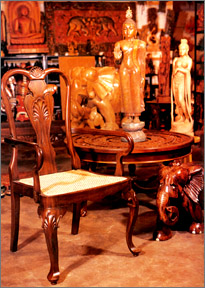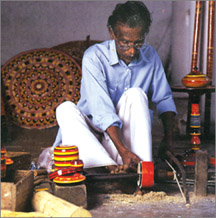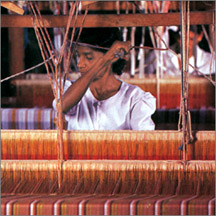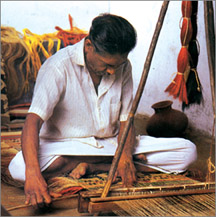Hope and help
Everything nowadays is plastic. A wham, a bham and there you have it.
Most of us would by now have forgotten how much work and time and pride
had gone into crafting even a simple, mundane thing as a reed mat in the
past if not for the dedicated craftsmen of the Central Province
by Aditha Dissanayake
|

Traditional woodcraft
|
Who would think a casual trip to Getambe, past the Botanical Gardens,
the Peradeniya Rest House, the Getambe temple, watching out for the
right bus-halt to get off at No. 41 would end up as an emotional journey
through history, a sojourn among old and new memories, a glance at hope
and help, and above all the discovery of tribes of craftsmen whose lives
are as colourful as their products.
On a recent visit to No. 41, the handicrafts showroom of the
Department of Industrial Development and Enterprise Promotion I find
myself in a world filled with the same kind of fascination Alice finds
in her wonderland.
From brass trays embossed with traditional motifs to silver plated
powder boxes, from Agasthi bracelets to Dumbara wall hangings, from
spectacles with Diyatarippu lenses to the traditional sesaths, every
product on display vouchsafe how the artisans scattered throughout the
Central Province continue to reproduce, with exactitude and fidelity to
original techniques and materials, the designs of our forefathers.
"Yet, these artisans have always been sidelined in our society"
laments Nishantha Wijeyalath, Assistant Director of the National Crafts
Council, Central Province. "They too should be seen as celebrities and
be given the kind of hero-worshipping lavished on pop-stars and actors
and actresses".
|

Lac and Sesath work
|
Describing the craftsmen of the Central Province as a seriously
endangered species in a changing environment with factory-made goods
replacing the time consuming, delicately carved work which are a
reflection of the pristine characteristics of the craftsmanship handed
down from generation to generation dating back to the days of the last
King of the country, Sri Wickramarajasinghe and the craft-dependent
mountain-way of life beginning to fade with the younger generation
seeking employment outside their villages, Wijayalath says the
organizations like the National Crafts Council and the Department of
Industrial Development and Enterprise Promotion are giving them a
helping hand by finding them markets through exhibitions, handicraft
showrooms and by conducting craft schools, the latter, which according
to Pushpa Dissanayake, who is involved in the training programmes,are
gradually becoming popular among the younger generations.
"We try to continue the traditions kept by our Kings who did their
best to encourage the craftsmen of the Kandy region" explains Wijeyalath.
"There are forty-four kinds of handicrafts produced in the Central
Province and we do our best to promote and appreciate the work of these
artisans by holding exhibitions at provincial and national levels
culminating in the annual Presidential Award Ceremony at the BMICH. The
Central Province bagged the highest number of awards last year with
eighty-one craftsmen winning prizes".
This is perhaps not a surprise given the fact that the Kandy and
Matale districts comprise several villages - each known for a particular
craft. Kurugala, for example, in Udunuwara is where the makers of
traditional Kandyan drums ranging from the geta bera to the rabana,
dwell.
|

Weaving of handloom fabrics |
In the fertile valley at the foot of the Hunnasgiri mountains is
Dumbara, where live the mat weavers, who extract the fibre from the leaf
of the hana (hemp) plant to create exquisite mats and wall hangings.
As Sarath C. Jayawardana says (in The Heritage of Kandyan Arts and
Crafts) this art of mat weaving confined to Dumbara valley is practised
in its original form preserved through generations and has acquired high
acclaim both from local and foreign buyers for their artistic qualities
and durability.
Adopting as they do, the finger nail technique for creating their
designs, the lac or Laksha workers in the village of Hapuvida in the
Matale district are the creators of a craft seen nowhere else in the
world.
According to Jayawardana the task of the lac worker which in the past
had been to decorate the arrow shafts, bed legs and walking sticks of
the nobility has today changed as most of these items are no longer in
use. Instead the present generation has begun to make sesath staves,
ashtrays, and halan heppu (jewellery boxes with a stand) using the same
techniques.
In making the Sesath, best described as a type of sunshade unique to
Sri Lanka with limited practical use in the present society, and kept as
a decorative item in some homes, Jayawardana writes that in making the
Sesath two schools of craftsmen meet, those who make the circular blade
living in Unaweruwa and those who make the long staff decorated with lac
living in Hapuvida, symbolizing the social and cultural unity of the
medieval Sri Lankan craftsmen.
Meanwhile, only at Talagune in Uda Dumbara does the weaving of
homespun cotton cloths still continue, with the descendants of the
indigenous weavers continuing to create hand-loom textiles called
Dumbara Rata.
Adhering to the same techniques passed down by the master craftsmen
of the Kandyan period the carpenters of Gunnepana and Nattarampota in
Kundasale create beautiful artifacts both secular and religious.
Different from the wood carvers of the maritime provinces who create
masks and puppets the Kandyan craftsmen as Jayawardana says "create
works of art depicting traditional Kandyan motifs and designs breathing
life into inert pieces of wood".
Close to the Gadaladeniya temple, in the remote village of Kahambe,
live the descendants of lapidarists who had made spectacles from a
variety of quartz called Diyatarippu during the days of the Kandyan
kings. As well as making optical lenses, the present day craftsmen are
also said to create magnifying glasses and reliquaries - artifacts which
are surely priceless.
|

Weavers of Dumbara mats and reedware Pix by Berty Gunasekera |
But the most popular cottage craft in the entire region is probably
the brass-work industry which is practised in the villages of Kiriwawula,
Pamunuwa, Danture, and in Kala Pura, in Nattarampotha. The specialists
in the art of jewellery making live in Hataraliyadda, Ullandupitiya and
Nilwala in the Kandy district and in Dehideniya in the Matale District.
One of the main problems faced by these artisans is the lack of raw
material, for which according to Wijayalath, a solution has now been
found. "We have begun to grow the raw material needed for some of the
handicrafts and in keeping with the theme of producing eco-friendly
products, have started to manufacture handbags, purses, and ornaments by
using fibre taken from banana trunks".
Admitting that he has not yet had time to prepare long term plans for
the National Crafts Council yet, the newly appointed Chairman of the
Council, Buddhi Keerthisena says he will be visiting the central
province to meet the craftsmen personally in order to find out about
their immediate needs.
"Right now we have identified that finding raw material is a major
problem in the silver and brass ware industry. We are trying to work out
a scheme to bring down the raw material (perhaps from India), duty
free".
Talking about promoting the handicraft industry in the Central
Province, Director, Department of Industrial Development and Enterprise
Promotion W.T.B Wanninayake who is also a newcomer having taken office
only three months ago says he plans to introduce a brochure at the
Peradeniya Botanical Gardens which would be issued with the ticket at
the entrance so that the visitors to the park could be lured to come and
visit the handicraft showroom in Getambe.
"We can assure all our customers that the products we sell are of
high quality because they have to be approved by a committee before they
are placed on the shelves".
Adding to this, Chandra Jayathunga, the Assistant Director -
Handicrafts says there are around 400 craftsmen who supply their crafts
to the showroom and that all of them are registered as craftsmen with
the Society of the Handicraft Artisans. The showroom which is in the
capable hands of Priyanka Wijethunga will undoubtedly become a great
attraction to the visitors of Kandy, given the right publicity.
As the sun set behind the hills of Hanthane, as I boarded a bus home,
having listened to, observed and become almost a part of the wonderful
world of the upcountry artisans I realize that mirroring the qualities
of the mountains, their crafts are lovely and strong, and that they, the
creators, are as colourful as their work.
[email protected]
|
